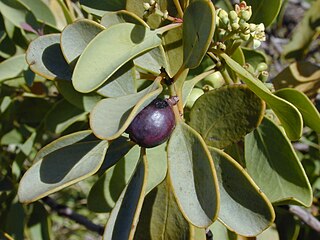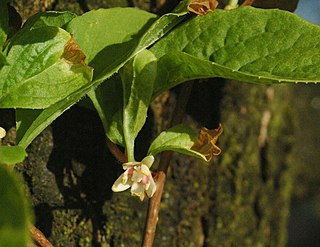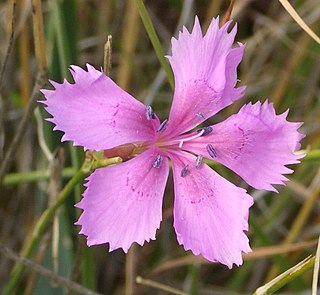
Asterales is an order of dicotyledonous flowering plants that includes the large family Asteraceae known for composite flowers made of florets, and ten families related to the Asteraceae. While asterids in general are characterized by fused petals, composite flowers consisting of many florets create the false appearance of separate petals.

The Magnoliaceae are a flowering plant family, the magnolia family, in the order Magnoliales. It consists of two genera: Magnolia and Liriodendron.

The Santalales are an order of flowering plants in the dicotyledons. Well-known members of the Santalales include sandalwoods and the many species of mistletoes. The order has a cosmopolitan distribution, but is heavily concentrated in tropical and subtropical regions. It derives its name from its type genus, Santalum (sandalwood).

Mistletoe is the common name for obligate hemiparasitic plants in the order Santalales. They are attached to their host tree or shrub by a structure called the haustorium, through which they extract water and nutrients from the host plant. There are hundreds of species which mostly live in tropical regions.

Agavoideae is a subfamily of monocot flowering plants in the family Asparagaceae, order Asparagales. It has previously been treated as a separate family, Agavaceae. The group includes many well-known desert and dry-zone types, such as the agaves and yuccas. About 640 species are placed in around 23 genera; they are widespread in the tropical, subtropical, and warm temperate regions of the world.

The Santalaceae, sandalwoods, are a widely distributed family of flowering plants which, like other members of Santalales, are partially parasitic on other plants. Its flowers are bisexual or, by abortion, unisexual. Modern treatments of the Santalaceae include the family Viscaceae (mistletoes), previously considered distinct.

Hemerocallidoideae is a subfamily of flowering plants, part of the family Asphodelaceae sensu lato in the monocot order Asparagales according to the APG system of 2016. Earlier classification systems treated the group as a separate family, the Hemerocallidaceae. The name is derived from the generic name of the type genus, Hemerocallis. The largest genera in the group are Dianella, Hemerocallis (15), and Caesia (11).

Scilloideae is a subfamily of bulbous plants within the family Asparagaceae. Scilloideae is sometimes treated as a separate family Hyacinthaceae, named after the genus Hyacinthus. Scilloideae or Hyacinthaceae include many familiar garden plants such as Hyacinthus (hyacinths), Hyacinthoides (bluebells), Muscari and Scilla and Puschkinia. Some are important as cut flowers.

The Angiosperm Phylogeny Group (APG) is an informal international group of systematic botanists who collaborate to establish a consensus on the taxonomy of flowering plants (angiosperms) that reflects new knowledge about plant relationships discovered through phylogenetic studies.

Asphodelaceae is a family of flowering plants in the order Asparagales. Such a family has been recognized by most taxonomists, but the circumscription has varied widely. In its current circumscription in the APG IV system, it includes about 40 genera and 900 known species. The type genus is Asphodelus.

Phrymaceae, also known as the lopseed family, is a small family of flowering plants in the order Lamiales. It has a nearly cosmopolitan distribution, but is concentrated in two centers of diversity, one in Australia, the other in western North America. Members of this family occur in diverse habitats, including deserts, river banks and mountains.

Schisandraceae is a family of flowering plants with 3 known genera and a total of 92 known species. Such a family has been recognized by most taxonomists, at least for the past several decades. Before that, the plants concerned were assigned to family Magnoliaceae and Illiciaceae.

Circaeasteraceae is a family of two species of herbaceous plants native to China and the Himalayas.
Plant taxonomy is the science that finds, identifies, describes, classifies, and names plants. It is one of the main branches of taxonomy.
The APG II system of plant classification is the second, now obsolete, version of a modern, mostly molecular-based, system of plant taxonomy that was published in April 2003 by the Angiosperm Phylogeny Group. It was a revision of the first APG system, published in 1998, and was superseded in 2009 by a further revision, the APG III system.

Boraginales is an order of flowering plants in the asterid clade, with a total of about 125 genera and 2,700 species. Different taxonomic treatments either include only a single family, the Boraginaceae, or divide it into up to eleven families. Its herbs, shrubs, trees and lianas (vines) have a worldwide distribution.

Olacaceae is a family of flowering plants in the order Santalales. They are woody plants, native throughout the tropical regions of the world. As of July 2021, the circumscription of the family varies; some sources maintain a broad family, others split it into seven segregate families.

Schoepfiaceae is a family of flowering plants recognized in the APG III system of 2009. The family was previously only recognized by few taxonomists; the plants in question usually being assigned to family Olacaceae and Santalaceae.

Caryophyllales is a diverse and heterogeneous order of flowering plants that includes the cacti, carnations, amaranths, ice plants, beets, and many carnivorous plants. Many members are succulent, having fleshy stems or leaves. The betalain pigments are unique in plants of this order and occur in all its core families with the exception of Caryophyllaceae and Molluginaceae. Noncore families, such as Nepenthaceae, instead produce anthocyanins.
The Asparagales are an order of plants, and on this page the structure of the order is used according to the APG III system. The order takes its name from the family Asparagaceae and is placed in the monocots. The order is clearly circumscribed on the basis of DNA sequence analysis, but is difficult to define morphologically, since its members are structurally diverse. The APG III system is used in World Checklist of Selected Plant Families from the Royal Botanical Gardens at Kew. With this circumscription, the order consists of 14 families with approximately 1120 genera and 26000 species.

















